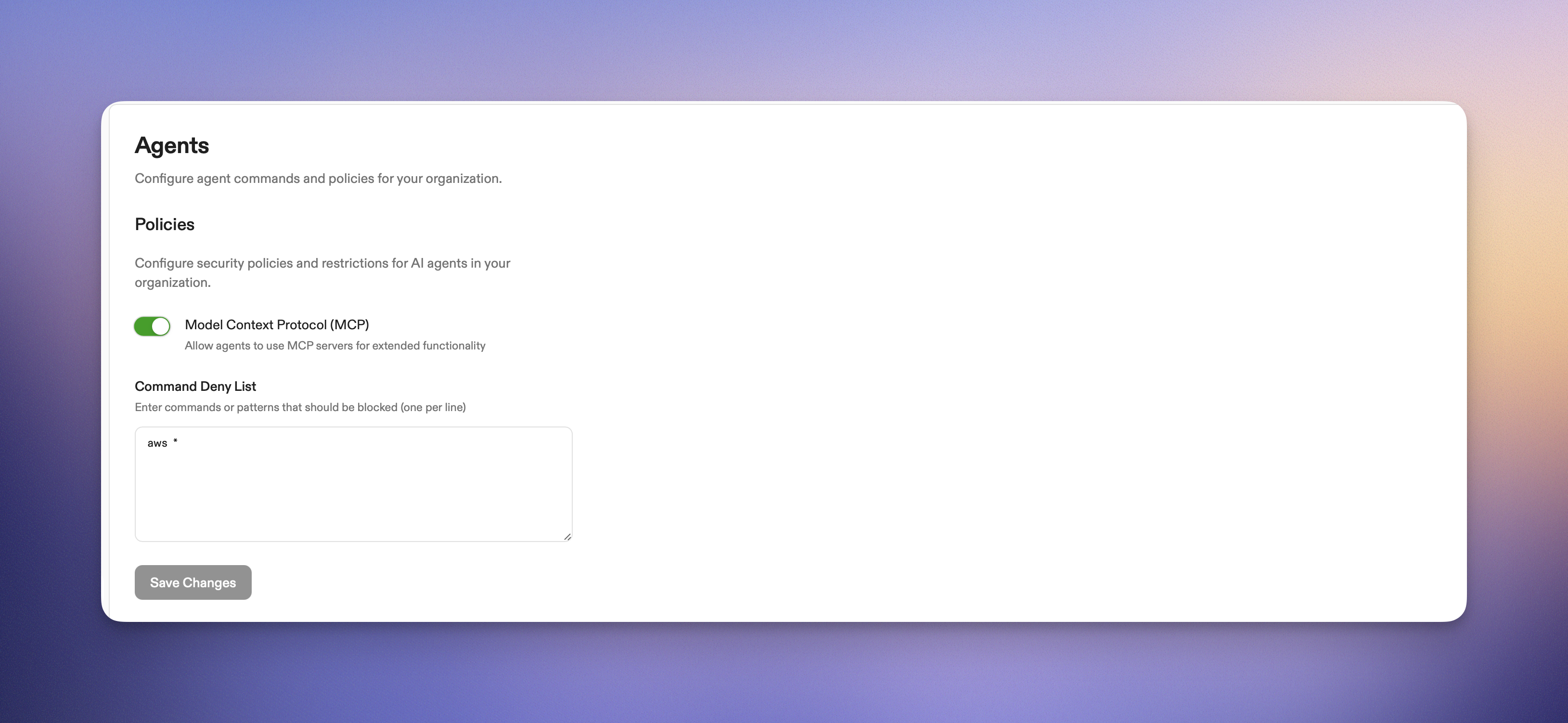
Configure command deny list patterns in Agents settings
What is the command deny list?
The command deny list is a security feature that allows organization administrators to block specific commands from being executed by Ona Agent within their organization’s environments. This provides fine-grained control over what actions Ona Agent can perform, helping maintain security standards and prevent potentially dangerous operations. With command deny lists, you can:- Block dangerous system commands like
aws * - Enforce security policies across all Ona Agent interactions
- Maintain compliance with organizational security requirements
How command blocking works
The deny list operates at multiple levels to provide comprehensive protection:Command execution flow
- User input: User provides input to Ona Agent (via chat, slash commands, or bash commands)
- Ona Agent decision: Ona Agent decides to execute a command using the
exectool - Permission check: The system checks the command against the organization’s deny list
- Execution or block: Commands are either executed (if allowed) or blocked with an error message
Pattern matching
The deny list supports flexible pattern matching:- Exact matching:
shutdownblocks exactly “shutdown” - Wildcard patterns:
shutdown*blocks “shutdown”, “shutdown -h”, “shutdown now” - Command families:
rm *blocks allrmcommands with arguments - Word-based matching: Patterns are matched word by word for precision
Important notes
- Slash commands (like
/clear,/support-bundle) are NOT directly blocked by deny lists. Slash commands are converted to prompts before reaching Ona Agent - Bash commands (prefixed with
!) are still subject to deny list filtering
Configure command deny lists
Where to configure
- Ensure you have selected your organization
- Navigate to Settings > Agents
Who can access
Only organization administrators can view and modify command deny lists. Regular members do not have access to these settings.How changes take effect
- Changes apply to new Ona Agent sessions
- Existing Ona Agent sessions must be restarted to apply new policies
Add deny list patterns
Basic configuration
- Navigate to Settings > Agents
- Locate the “Policies” section
- Add command patterns to the “Command Deny List” field, one per line
- Save your changes

Configure command deny list patterns in Agents settings
Example deny list patterns
Here are common patterns you might want to include:Effect on users
When commands are blocked
Users will see clear error messages when Ona Agent attempts to execute blocked commands:User experience
- No impact on manual commands: Users can still run commands directly in their terminals
- Ona Agent limitations: Only Ona Agent command execution is restricted
- Clear feedback: Users receive informative error messages explaining why commands were blocked
- No retry attempts: Ona Agent is instructed not to retry blocked commands
Pattern best practices
- Start with broad patterns: Use
aws *instead of listing everyawsvariant - Test thoroughly: Verify patterns work as expected in a test environment
- Document your choices: Keep a record of why specific patterns were added
- Regular review: Periodically review and update patterns based on usage
Security considerations
What the deny list protects against
- Accidental destructive commands: Prevents Ona Agent from accidentally running dangerous operations
- Malicious prompt injection: Blocks attempts to trick Ona Agent into running harmful commands
- Compliance violations: Ensures Ona Agent doesn’t perform actions that violate organizational policies
- Resource abuse: Prevents commands that could consume excessive system resources
What the deny list does not protect against
- Direct user commands: Users can still run any command directly in their terminal
- Application-level actions: Commands executed within applications (not system commands)
- Slash command abuse: Slash commands themselves cannot be blocked via deny lists
Test your configuration
To test your deny list configuration:- Create a new environment
- Ask Ona Agent to run a command that should be blocked
- Verify the command is blocked with an appropriate error message